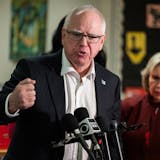Where Stephen Gregg lives, near 26th Street and Bloomington Avenue in the working-class south Minneapolis neighborhood of East Phillips, used needles litter the sidewalks. In summer, large groups congregate against the storefronts and use drugs openly to the distress of neighbors, who occasionally find bodies in their yards, Gregg said.
Gregg approached the East Phillips Improvement Coalition neighborhood association to explore the possibility of creating an overdose prevention site, also known as a supervised drug consumption site.
"This is the most diverse neighborhood in the city. It's one of the poorest. We've had all these environmental harms. It's just a dumping ground for the city, and this is also where these issues happen," said Gregg. "We have a homelessness epidemic and an opioid epidemic, and it shouldn't be the neighbors who have to battle that."
He wrote a column for the neighborhood newspaper, the Alley, asking residents to acknowledge the reality of drugs in East Phillips. Gregg also asked them to consider creating a facility where staff trained to administer naloxone, also known as Narcan, can provide sterile needles, prevent overdoses and refer treatment.
Southside Harm Reduction Services, which runs a needle exchange and contracts with the city Health Department to provide Narcan training, has been hosting educational presentations on overdose prevention sites the past few months. They and East Phillips neighbors plan to survey the appetite of the neighborhood through a mix of door-knocking and outreach to people who use drugs.
The concept is far from implementation. There is no specific location under discussion, nor any established operator.
"It would be a great idea because we have people using and the reality is they're not going to stop unless they really want to," said East Phillips Improvement Coalition Secretary Cassandra Holmes. "Instead of losing our relatives, we should be able to provide a space where they can use safely and we won't have needles laying about for kids or animals or other people to be harmed."
Minneapolis is in the midst of an HIV outbreak with rates unseen since the beginning of the HIV crisis in the 1980s, said Noya Woodrich, the city's Deputy Health Commissioner, who ties the outbreak to encampments and intravenous drug use. The Minnesota Department of Health's latest stats also show there were 27% more overdose deaths in 2020 than 2019.
![A black bear stopped after crossing Big Bay Road on Madeline Island, the largest of the Apostle Islands in Wisconsin, on Monday, May 31, 2021. ]](https://arc.stimg.co/startribunemedia/PWNYGIY3WTSWDBOGOYD775DPP4.jpg?&w=80&ar=1:1&fit=crop)

